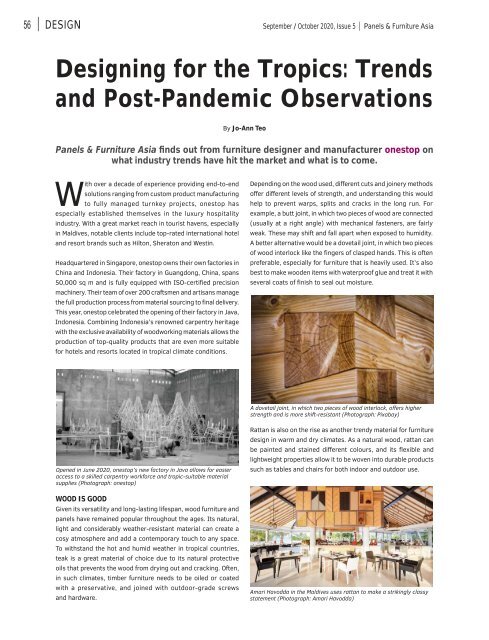Panels & Furniture Asia September/October 2020
Panels & Furniture Asia (PFA) is a leading regional trade magazine dedicated to the woodbased panel, furniture and flooring processing industry. Published bi-monthly since 2000, PFA delivers authentic journalism to cover the latest news, technology, machinery, projects, products and trade events throughout the sector. With a hardcopy and digital readership comprising manufacturers, designers and specifiers, among others, PFA is the platform of choice for connecting brands across the global woodworking landscape.
Panels & Furniture Asia (PFA) is a leading regional trade magazine dedicated to the woodbased panel, furniture and flooring processing industry. Published bi-monthly since 2000, PFA delivers authentic journalism to cover the latest news, technology, machinery, projects, products and trade events throughout the sector. With a hardcopy and digital readership comprising manufacturers, designers and specifiers, among others, PFA is the platform of choice for connecting brands across the global woodworking landscape.
You also want an ePaper? Increase the reach of your titles
YUMPU automatically turns print PDFs into web optimized ePapers that Google loves.
56 | DESIGN<br />
<strong>September</strong> / <strong>October</strong> <strong>2020</strong>, Issue 5 | <strong>Panels</strong> & <strong>Furniture</strong> <strong>Asia</strong><br />
Designing for the Tropics: Trends<br />
and Post-Pandemic Observations<br />
By Jo-Ann Teo<br />
<strong>Panels</strong> & <strong>Furniture</strong> <strong>Asia</strong> finds out from furniture designer and manufacturer onestop on<br />
what industry trends have hit the market and what is to come.<br />
With over a decade of experience providing end-to-end<br />
solutions ranging from custom product manufacturing<br />
to fully managed turnkey projects, onestop has<br />
especially established themselves in the luxury hospitality<br />
industry. With a great market reach in tourist havens, especially<br />
in Maldives, notable clients include top-rated international hotel<br />
and resort brands such as Hilton, Sheraton and Westin.<br />
Headquartered in Singapore, onestop owns their own factories in<br />
China and Indonesia. Their factory in Guangdong, China, spans<br />
50,000 sq m and is fully equipped with ISO-certified precision<br />
machinery. Their team of over 200 craftsmen and artisans manage<br />
the full production process from material sourcing to final delivery.<br />
This year, onestop celebrated the opening of their factory in Java,<br />
Indonesia. Combining Indonesia’s renowned carpentry heritage<br />
with the exclusive availability of woodworking materials allows the<br />
production of top-quality products that are even more suitable<br />
for hotels and resorts located in tropical climate conditions.<br />
Depending on the wood used, different cuts and joinery methods<br />
offer different levels of strength, and understanding this would<br />
help to prevent warps, splits and cracks in the long run. For<br />
example, a butt joint, in which two pieces of wood are connected<br />
(usually at a right angle) with mechanical fasteners, are fairly<br />
weak. These may shift and fall apart when exposed to humidity.<br />
A better alternative would be a dovetail joint, in which two pieces<br />
of wood interlock like the fingers of clasped hands. This is often<br />
preferable, especially for furniture that is heavily used. It’s also<br />
best to make wooden items with waterproof glue and treat it with<br />
several coats of finish to seal out moisture.<br />
A dovetail joint, in which two pieces of wood interlock, offers higher<br />
strength and is more shift-resistant (Photograph: Pixabay)<br />
Opened in June <strong>2020</strong>, onestop’s new factory in Java allows for easier<br />
access to a skilled carpentry workforce and tropic-suitable material<br />
supplies (Photograph: onestop)<br />
WOOD IS GOOD<br />
Given its versatility and long-lasting lifespan, wood furniture and<br />
panels have remained popular throughout the ages. Its natural,<br />
light and considerably weather-resistant material can create a<br />
cosy atmosphere and add a contemporary touch to any space.<br />
To withstand the hot and humid weather in tropical countries,<br />
teak is a great material of choice due to its natural protective<br />
oils that prevents the wood from drying out and cracking. Often,<br />
in such climates, timber furniture needs to be oiled or coated<br />
with a preservative, and joined with outdoor-grade screws<br />
and hardware.<br />
Rattan is also on the rise as another trendy material for furniture<br />
design in warm and dry climates. As a natural wood, rattan can<br />
be painted and stained different colours, and its flexible and<br />
lightweight properties allow it to be woven into durable products<br />
such as tables and chairs for both indoor and outdoor use.<br />
Amari Havodda in the Maldives uses rattan to make a strikingly classy<br />
statement (Photograph: Amari Havodda)


















